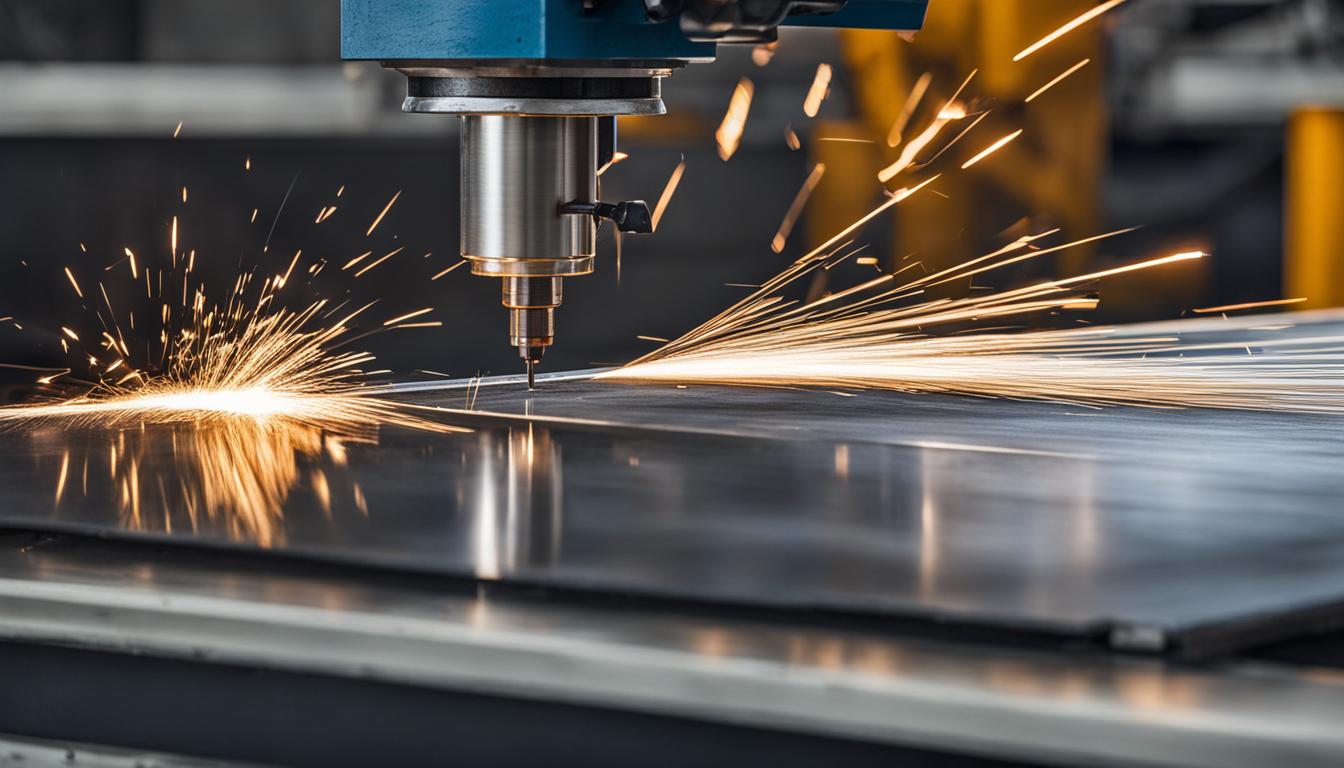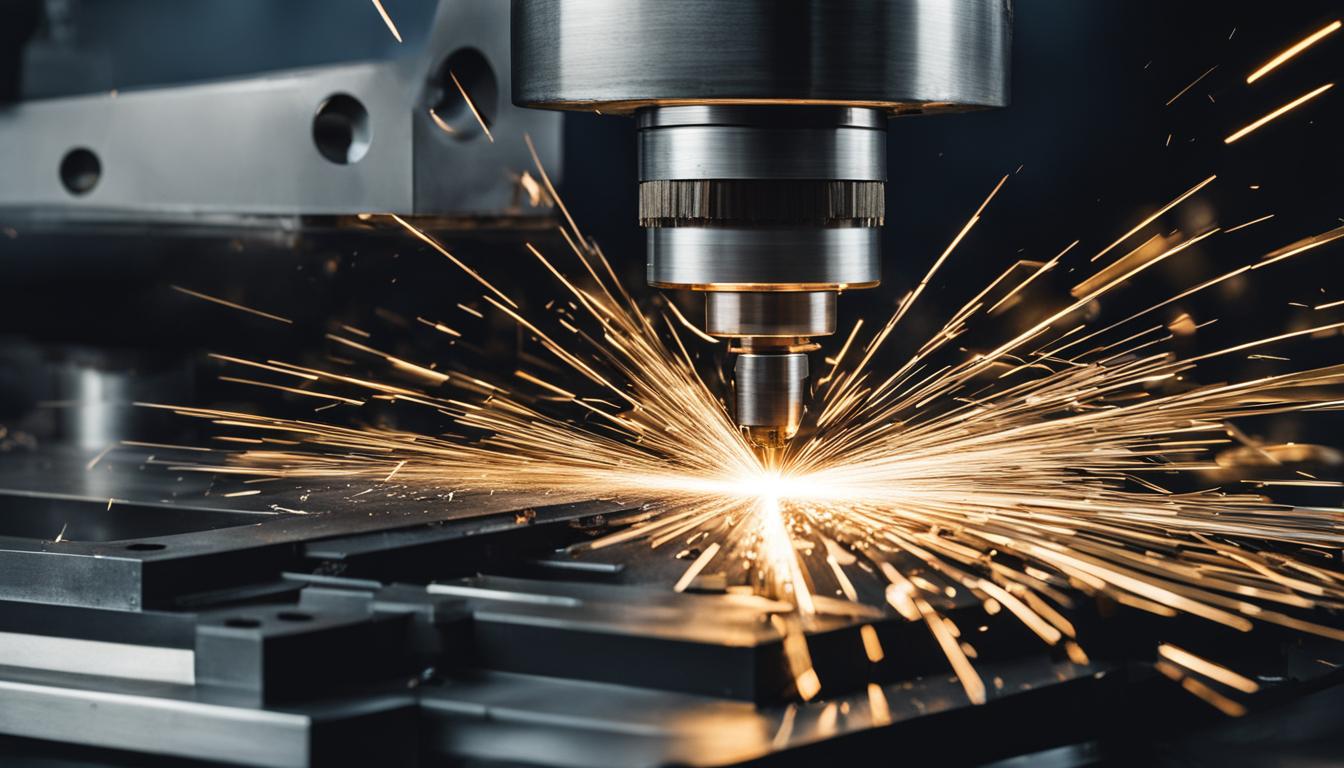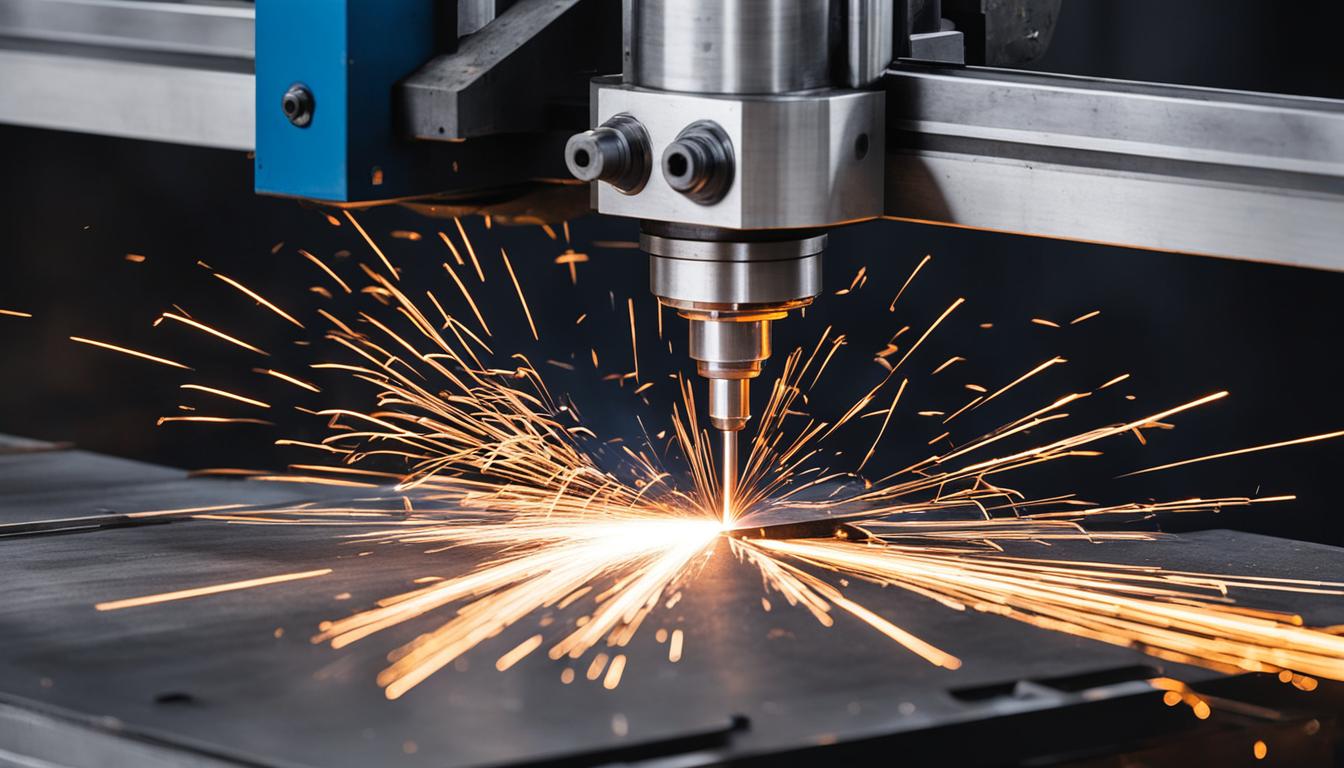When it comes to cutting metal, CNC machines offer unparalleled precision and efficiency. These computer numerical control machines are programmable and use computerized controls to operate machine tools that remove layers of material, resulting in custom-designed parts.
If you’re wondering what kind of CNC machine cuts metal, you’ve come to the right place. In this article, we’ll explore different types of CNC machines specifically designed for cutting metal and delve into their unique capabilities and applications.
Whether you’re in the field of electronics, woodworking, drilling, turning, or more, there is a specialized CNC machine for your metal cutting needs. From pick and place machines in electronic manufacturing to router CNC machines for wood cutting, the options are vast.
If you’re looking to create precise cylindrical holes, drilling CNC machines are the go-to choice, while lathe CNC machines excel in the turning process. For intricate, complex parts manufacturing, the 5-axis CNC machine is a game-changer. And for precision shaping, milling CNC machines become indispensable tools.
But the applications don’t stop there. Plasma cutting CNC machines use high-powered torches to cut through tough metals, while laser cutting CNC machines are known for their versatility, cutting both non-metal and metal materials with precision. And let’s not forget the electric discharge CNC machine, which shapes materials using controlled sparks.
In the following sections, we’ll delve into each type of CNC machine in more detail, exploring their features, benefits, and specific applications in various industries. So if you’re looking to enhance your metal cutting processes, keep reading to discover the perfect CNC machine for your needs.
Pick and Place Machine
In the field of electronic manufacturing, pick and place machines play a crucial role in the efficient production of electronic devices. These machines are a type of CNC machine that automates the process of placing electrical components onto a circuit board.
Using multiple nozzles, pick and place machines precisely lift and accurately position tiny electrical components onto the circuit board, ensuring proper alignment and soldering. This highly precise and automated process significantly improves productivity and reduces human errors.
Pick and place machines have become essential in the production of cell phones, computers, tablets, and various other electronic devices. They enable manufacturers to achieve higher production volumes, maintain consistency in component placement, and enhance the overall quality of electronic products.
Benefits of Pick and Place Machines:
- Increased productivity and efficiency in electronic manufacturing processes.
- Precision and accuracy in component placement, reducing the risk of errors.
- Improved manufacturing consistency and quality control.
- Cost-effective automation that reduces labor-intensive tasks.
- Flexibility to handle various electronic components of different sizes and shapes.
Overall, pick and place machines have revolutionized the electronic manufacturing industry by combining the capabilities of CNC technology with precise component placement. They have become an indispensable tool for manufacturers, enabling them to meet the growing demands for electronic devices with speed, precision, and consistency.
| Key Features | Advantages |
|---|---|
| High-speed component placement | Efficiency in production |
| Precision alignment and soldering | Improved quality control |
| Compatibility with various component sizes and shapes | Flexible production capabilities |
| Automated component handling | Reduced labor-intensive tasks |
Router CNC Machine
A router CNC machine is a versatile tool that is primarily used for machining softer materials such as wood, steel, foam, composites, aluminum, and plastic. This type of CNC machine utilizes computer numerical control to precisely route spindle and machine tool paths, shaping the materials according to the desired design.
Router CNC machines offer numerous benefits, including:
- Reduced Waste: The precision and accuracy of the machine result in minimal material waste, ensuring optimal use of resources.
- Increased Productivity: With their automated operations, router CNC machines can execute complex designs and produce finished products at a faster rate compared to traditional methods.
- High Precision: CNC routing allows for intricate detailing and precise cutting, ensuring the production of products with exceptional accuracy.
The versatility of router CNC machines makes them suitable for a wide range of applications, such as woodworking, sign making, cabinetry, and prototyping. Whether you need to create intricate designs, carve intricate patterns, or produce custom shapes, a router CNC machine provides the precision and efficiency required for your project.
Wood Cutting Capability
One of the key strengths of router CNC machines is their ability to cut through wood with precision. From softwoods like pine to hardwoods like oak, these machines can handle a variety of wood types, enabling the creation of intricate woodwork designs.
Here is an example table highlighting some of the common wood materials and their suitability for CNC routing:
| Wood Species | Suitability for CNC Routing |
|---|---|
| Pine | Highly suitable for CNC routing due to its softness and ease of cutting. |
| MDF (Medium-Density Fiberboard) | Popular choice for CNC routing as it offers a smooth surface and consistent density. |
| Maple | Hardwood that requires careful selection of cutting parameters due to its density. |
| Walnut | Hardwood with rich color and grain patterns, suitable for intricate carving and routing. |
The use of a router CNC machine for wood cutting ensures precise and efficient production, enabling craftsmen and manufacturers to bring their creative visions to life.

With its versatility, precision, and ability to work on a wide range of materials, a router CNC machine is an essential tool for anyone involved in woodworking, prototyping, or custom fabrication.
Drilling CNC Machine
A drilling CNC machine is specifically designed for creating cylindrical holes in a workpiece. It utilizes rotating drill bits to remove material and produce the desired hole shape. This type of CNC machine is widely used in industries such as automotive, aerospace, and construction.
Types of Drill Bits
There are various types of drill bits available for specific drilling applications. Some commonly used drill bits include:
- Spotting Drills: These are short, high-speed drill bits used for centering and spotting holes before drilling.
- Peck Drills: These drill bits have a special design that allows them to drill deep holes by periodically retracting to remove chips.
- Screw Machine Drills: These drill bits are optimized for drilling in high-production environments, such as those found in screw machines.
- Chucking Reamers: These drill bits are used for enlarging holes and improving their accuracy.
Each type of drill bit has its own unique characteristics and benefits, making them suitable for specific drilling tasks.
Drilling CNC machines play a crucial role in the manufacturing process, enabling precise and efficient hole drilling. They offer benefits such as increased productivity, reduced waste, and improved accuracy. Whether it’s drilling holes for fasteners, creating holes for electrical wiring, or any other hole drilling application, a drilling CNC machine is an indispensable tool in various industries.
| Advantages of Drilling CNC Machine | Applications |
|---|---|
| High precision drilling | Automotive |
| Efficient and fast drilling process | Aerospace |
| Versatility for different hole sizes and shapes | Construction |
Lathe CNC Machine
A lathe CNC machine is a versatile tool used in the turning process, which involves removing material from a rotating workpiece using single-point cutting tools. This process allows for the creation of various shapes and designs, making it a crucial component in metal turning operations.
Using a lathe CNC machine, manufacturers can produce symmetrical objects with cylindrical or conical shapes. The machine’s turning tools are designed for different applications, such as roughing, finishing, threading, and grooving, ensuring precise and efficient machining results.
CNC lathes are widely used in various industries, including automotive, aerospace, and furniture manufacturing. They can produce a wide range of products, including automobile parts, musical instruments, and furniture components.
Advantages of a Lathe CNC Machine
- Allows for precise shaping and finishing of workpieces
- Enables the production of symmetrical objects with high accuracy
- Offers versatility in machining operations, such as threading and grooving
- Increases productivity and efficiency in the metal turning process
- Reduces material waste through optimized cutting techniques

| Applications | Benefits |
|---|---|
| Automotive industry | Manufacturing of engine parts, shafts, and gears |
| Aerospace industry | Production of turbine blades, aerospace components |
| Furniture industry | Creation of wooden and metal furniture components |
5-Axis CNC Machine
A 5-axis CNC machine is a valuable tool in the realm of machining, offering enhanced capabilities for complex parts manufacturing. By adding two rotational axes to the traditional 3-axis linear motions (X, Y, Z), a 5-axis CNC machine provides superior flexibility and precision in machining operations.
With the ability to access five out of six sides of a part in a single operation, 5-axis CNC machines are well-suited for the production of intricate components, especially in industries such as aerospace and sculpture. The multi-axis machining capability allows for the creation of complex geometries and contours that would be challenging or impossible to achieve with conventional machining methods.
Benefits of 5-Axis CNC Machines
5-axis CNC machines offer several advantages over their 3-axis counterparts:
- Enhanced machining flexibility: The additional rotational axes enable machining operations from multiple angles, allowing for intricate cuts and shapes.
- Improved accuracy: By reducing the need for repositioning the workpiece, 5-axis CNC machines minimize errors and increase overall machining precision.
- Reduced setup time: With the ability to perform complex operations in a single setup, these machines minimize the time and effort required for preparing the workpiece.
- Increased productivity: The combination of enhanced flexibility, accuracy, and reduced setup time contributes to greater productivity in complex parts manufacturing.
5-axis CNC machines are essential tools for manufacturers seeking to produce high-quality components with intricate designs. Their versatility and advanced capabilities make them indispensable in industries where complex parts manufacturing is a critical requirement.
| Key Features of 5-Axis CNC Machines | Applications |
|---|---|
| Simultaneous control of multiple axes | Aerospace component manufacturing |
| Precision machining of complex parts | Sculpture and artistic work |
| Reduced need for repositioning | Medical device production |
| High accuracy and repeatability | Tool and die making |
| Flexible toolpath generation | Automotive component fabrication |
Milling CNC Machine
A milling CNC machine is a versatile tool used for precision shaping of various materials such as metal, wood, and plastic. It utilizes rotating multi-point cutting tools to remove material and achieve the desired shape. CNC milling machines have three-axis movements, allowing for precise control and accurate shaping. More advanced models can accommodate additional axes, enabling even more complex shaping operations.
These machines can be oriented horizontally or vertically, depending on the specific application. They offer a wide range of cutting tools, including end mills, helical mills, and chamfer mills, to cater to different shaping requirements. The multi-point cutting tools deliver high cutting efficiency and can produce intricate designs with exceptional precision.
CNC milling machines are widely used in various industries, including manufacturing, aerospace, automotive, and prototyping. They are preferred for their ability to achieve tight tolerances, produce smooth surfaces, and generate complex shapes. The precision shaping capabilities of milling CNC machines make them indispensable tools for creating custom parts, molds, prototypes, and other components.
Benefits of Milling CNC Machines:
- Precision shaping: The multi-point cutting tools and precise control mechanisms of milling CNC machines enable accurate shaping of materials.
- Efficiency: By utilizing multi-point cutting tools, milling CNC machines can efficiently remove material, reducing waste and optimizing production processes.
- Versatility: These machines can work with a wide range of materials, including metal, wood, and plastic, making them suitable for various applications.
- Flexibility: CNC milling machines offer three-axis movements and can accommodate additional axes for more complex shaping operations, providing flexibility in design and production.
- Automation: The computer numerical control system automates the milling process, ensuring consistency, repeatability, and reduced human error.
| Advantages | Disadvantages |
|---|---|
| High precision shaping | Initial setup and programming may require expertise |
| Efficient material removal | Higher initial cost compared to manual milling |
| Wide range of compatible materials | Requires regular maintenance and calibration |
| Accommodates complex shaping operations | May generate noise and produce debris |
| Automation for consistent production | Requires a dedicated workspace and power source |
Plasma Cutting CNC Machine
A plasma cutting CNC machine is a powerful tool used for cutting electrically conductive materials with precision. It utilizes a high-powered torch that generates an electric arc to turn gas into plasma, allowing for efficient and accurate metal cutting. This technology is particularly effective for tough materials like titanium and steel.
With a plasma cutting CNC machine, you can easily work with materials such as brass, copper, aluminum, steel, and stainless steel. The high-powered torch, created by passing high-velocity gas through a nozzle, produces a focused heat source that rapidly melts and cuts through the metal.
Plasma cutting machines offer several advantages in metal cutting processes. They provide high cutting speeds, precise control, and minimal heat-affected zones, resulting in clean and accurate cuts. Whether you need to cut intricate designs or thick metal plates, a plasma cutting CNC machine is a reliable and efficient solution.
Advantages of Plasma Cutting CNC Machines:
- Efficient cutting of electrically conductive materials
- High cutting speeds
- Precise control
- Minimal heat-affected zones
- Ability to cut tough materials like titanium and steel
| Materials | Advantages |
|---|---|
| Brass | – High cutting speeds – Precise control |
| Copper | – Minimal heat-affected zones |
| Aluminum | – Efficient cutting |
| Steel | – Ability to cut thick metal plates |
| Stainless Steel | – Clean and accurate cuts |
Laser Cutting CNC Machine
Laser cutting CNC machines are highly versatile tools that utilize different types of lasers for precision cutting. Two commonly used lasers in laser cutting CNC machines are CO2 lasers and solid-state lasers.
CO2 Lasers
CO2 lasers are widely used in laser cutting CNC machines for cutting non-metal materials. These lasers emit a high-energy beam of light that interacts with the material, vaporizing or melting it to create clean and precise cuts. CO2 lasers are particularly effective for cutting materials such as wood, acrylic, leather, fabric, and paper.
Solid-State Lasers
Solid-state lasers are suitable for cutting through metals, making them an excellent choice for industries requiring precision cutting of metal materials. These lasers generate a concentrated beam of light that rapidly heats and melts the metal, allowing for smooth and accurate cuts. Solid-state lasers can effectively cut various metals, including steel, aluminum, copper, and titanium.
Laser cutting machines offer numerous advantages in terms of precision, versatility, and efficiency. They are widely used in industries such as aerospace, automotive, and medical, where precise cutting of different materials is crucial. With laser cutting CNC machines, manufacturers can achieve intricate designs and shapes with minimal material waste.
| Laser Cutting CNC Machine | Applications |
|---|---|
| CO2 Lasers | Wood, acrylic, leather, fabric, paper |
| Solid-State Lasers | Steel, aluminum, copper, titanium |
Electric Discharge CNC Machine
An electric discharge CNC machine, also known as a spark CNC machine, is a cutting-edge technology that utilizes controlled sparks to reshape various materials. By harnessing the transient effect of electric discharge, this machine is capable of precisely removing material and creating intricate shapes. Electric discharge CNC machines are particularly well-suited for manufacturing parts that require complex geometries and uncompromising precision.
These innovative machines have widespread applications across industries such as automotive, aerospace, and mold making. In the automotive sector, electric discharge CNC machines play a critical role in shaping components with intricate designs, including engine parts and transmission components. Likewise, in the aerospace industry, these machines are instrumental in fabricating intricate turbine blades and other vital aircraft components. Additionally, in the mold making industry, electric discharge CNC machines enable the production of intricate molds for injection molding processes.
With their ability to shape a wide range of materials, including metals, ceramics, and even exotic alloys, electric discharge CNC machines offer unparalleled versatility. The spark CNC machine’s exceptional precision guarantees the production of parts with remarkably tight tolerances, ensuring optimal performance and functionality.
The spark CNC machine’s ability to shape materials using controlled electric sparks brings a new level of efficiency and accuracy to the manufacturing process. As technology continues to advance, electric discharge CNC machines will undoubtedly become an indispensable tool for industries seeking to create intricate and highly precise components.
